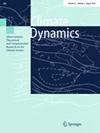Assessment of seasonal forecasting errors of the ECMWF system in the eastern Indian Ocean
IF 3.7
2区 地球科学
Q2 METEOROLOGY & ATMOSPHERIC SCIENCES
引用次数: 0
Abstract
Abstract The interannual variability of the Equatorial Eastern Indian Ocean (EEIO) is highly relevant for the climate anomalies on adjacent continents and affects global teleconnection patterns. Yet, this is an area where seasonal forecasting systems exhibit large errors. Here we investigate the reasons for these errors in the ECMWF seasonal forecasting system SEAS5 using tailored diagnostics and a series of numerical experiments. Results indicate that there are two fundamental and independent sources of forecast errors in the EEIO. The first one is of atmospheric nature and is largely related with too strong and stable easterly atmospheric circulation present in the equatorial Indian Ocean. This induces an easterly bias which leaves the coupled model predominantly in a state with a shallow thermocline and cold SSTs in the EEIO. The second error is of oceanic origin, associated with a too shallow thermocline, which enhances the SST errors arising from errors in the wind. Ocean initial conditions, which depend on both the quality of the assimilation and the ocean model, play an important role in this context. Nevertheless, it is found that the version of the ocean model used for the forecast can also play a non-negligible role at the seasonal time scales, by amplifying or damping the subsurface errors in the initial conditions. Errors in the EEIO are regime-dependent, having different causes in the warm (deep thermocline) regime with strong atmospheric convection and in the cold (shallow thermocline) regime. Errors also exhibit decadal variations, which challenges the calibration methods used in seasonal forecasts.东印度洋ECMWF系统季节预报误差的评估
赤道东印度洋(EEIO)的年际变率与邻近大陆的气候异常高度相关,并影响全球遥相关模式。然而,在这一领域,季节预报系统显示出很大的误差。在这里,我们使用定制诊断和一系列数值实验来研究ECMWF季节预报系统SEAS5中这些误差的原因。结果表明,EEIO预报误差有两个基本而独立的来源。第一个是大气性质的,主要与赤道印度洋存在的太强和稳定的偏东大气环流有关。这导致偏东,使耦合模式主要处于浅层温跃层和EEIO冷海温的状态。第二个误差来自海洋,与过浅的温跃层有关,它增强了由风的误差引起的海温误差。海洋初始条件在这方面起着重要作用,它既取决于同化的质量,也取决于海洋模式。然而,我们发现用于预报的海洋模式的版本在季节时间尺度上也可以发挥不可忽视的作用,因为它放大或减弱了初始条件下的地下误差。EEIO的误差与气候有关,在具有强大气对流的温暖(深层温跃层)和寒冷(浅层温跃层)有不同的原因。误差也表现出年代际变化,这对季节性预报中使用的校准方法提出了挑战。
本文章由计算机程序翻译,如有差异,请以英文原文为准。
求助全文
约1分钟内获得全文
求助全文
来源期刊

Climate Dynamics
地学-气象与大气科学
CiteScore
8.80
自引率
15.20%
发文量
483
审稿时长
2-4 weeks
期刊介绍:
The international journal Climate Dynamics provides for the publication of high-quality research on all aspects of the dynamics of the global climate system.
Coverage includes original paleoclimatic, diagnostic, analytical and numerical modeling research on the structure and behavior of the atmosphere, oceans, cryosphere, biomass and land surface as interacting components of the dynamics of global climate. Contributions are focused on selected aspects of climate dynamics on particular scales of space or time.
The journal also publishes reviews and papers emphasizing an integrated view of the physical and biogeochemical processes governing climate and climate change.
 求助内容:
求助内容: 应助结果提醒方式:
应助结果提醒方式:


